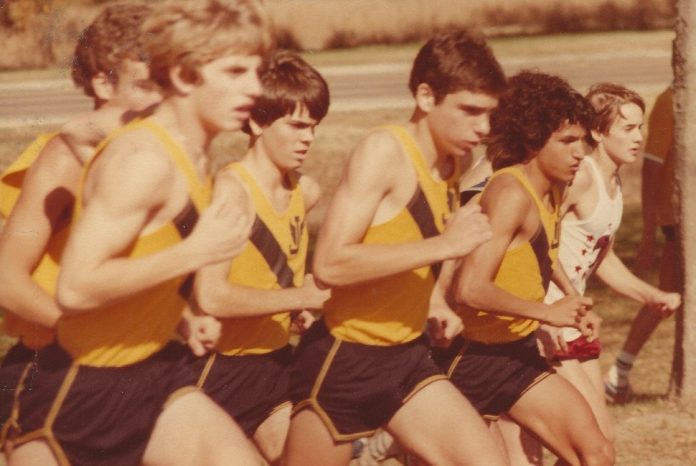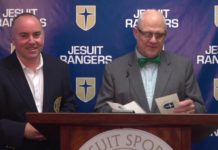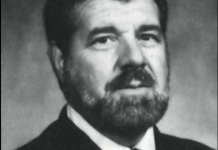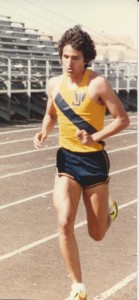 Jesuit’s Profile of the Graduate at Graduation features six components: open to growth, committed to social justice, intellectually competent, loving, religious, and physically fit. While all students strive to encompass all of these aspects, most are strongest in one area or another. For those who have exceptionally displayed their God-given talents in athletics, Jesuit has its own Sports Hall of Fame, which showcases the best athletes that Jesuit has ever produced.
Jesuit’s Profile of the Graduate at Graduation features six components: open to growth, committed to social justice, intellectually competent, loving, religious, and physically fit. While all students strive to encompass all of these aspects, most are strongest in one area or another. For those who have exceptionally displayed their God-given talents in athletics, Jesuit has its own Sports Hall of Fame, which showcases the best athletes that Jesuit has ever produced.
Four alumni, John Koeijmans ’77, Mike Flynn ’79, Jaime Najera ’81 and Chuck Hazzard ’93, will be the next inductees, announced the Jesuit Dallas Alumni Lettermen’s Club. The group will be inducted at the 2014 Blue & Gold Sports Hall of Fame Induction Ceremony on Saturday, May 3 in the Terry Center. The four alumni will each be profiled by the Roundup.
One of these new inductees, Jaime Najera, served as an outstanding track and cross country runner throughout his Jesuit tenure, earning five letters at Jesuit before moving on to earn eight more in college.
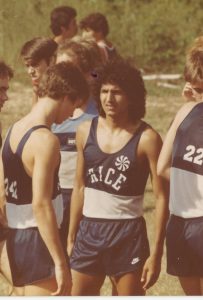 Born and raised in Dallas, Najera attended Holy Trinity Catholic School, and was introduced to Jesuit through the HAP Program. In this program, Jesuit reaches out to the inner city schools by providing summer enrichment programs in math and English.
Born and raised in Dallas, Najera attended Holy Trinity Catholic School, and was introduced to Jesuit through the HAP Program. In this program, Jesuit reaches out to the inner city schools by providing summer enrichment programs in math and English.
Najera actually began his Jesuit athletics career in another sport. After playing many years of soccer in grade school, he was a member of the Jesuit freshman and JV soccer teams.
Despite his love of the game, Najera “knew [his] limitations in soccer. I just knew I probably was not going to be one of the better ones. A lot of people always told me, ‘you’re pretty fast,’ so I decided to go out for track after the soccer season my sophomore year.”
In his first season of track, Najera mainly practiced with the team but did not do much training outside of that. He improved during the season running the 300 m hurdles, and in the summer following he decided to try cross country.
Starting out in cross country his junior year, Najera felt “a little behind” because he didn’t do much running in the summer—“unaware on how to train offseason.” He began at the back of the pack around 12 or 15th on the team, but with every race he improved and by three or four races into the season he had made varsity. By the end of the year, he had finished second on the team, giving him “the confidence to continue to train outside of practice to really improve.”
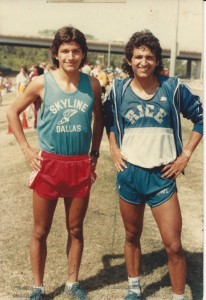 In track, Najera previously ran the 300 hurdles because no one else ran it, and the varsity team can only send three runners in every event. Coach Randy Best wanted him to keep running hurdles in his junior season (both 110 m and 300 m), but Najera wanted to try some different races, hinting that he could do the 800. Coach Best was against it because he already had three half milers, yet gave Najera a chance during a dual meet with North Mesquite. According to Najera, North Mesquite “had a guy who was ranked in the state, but I didn’t know any differently. He took off and ran really well, but I kinda tacked on and did my own thing and got second. I ended up running a 2:02, 2:03 in the half mile, and that was five or six seconds better than anyone else on the team. Coach Best came up to me after the race and said, ‘You’re a half miler.'” The 800 m was thus his primary event for the remainder of high school.
In track, Najera previously ran the 300 hurdles because no one else ran it, and the varsity team can only send three runners in every event. Coach Randy Best wanted him to keep running hurdles in his junior season (both 110 m and 300 m), but Najera wanted to try some different races, hinting that he could do the 800. Coach Best was against it because he already had three half milers, yet gave Najera a chance during a dual meet with North Mesquite. According to Najera, North Mesquite “had a guy who was ranked in the state, but I didn’t know any differently. He took off and ran really well, but I kinda tacked on and did my own thing and got second. I ended up running a 2:02, 2:03 in the half mile, and that was five or six seconds better than anyone else on the team. Coach Best came up to me after the race and said, ‘You’re a half miler.'” The 800 m was thus his primary event for the remainder of high school.
Najera earned all-state recognition every year, was a five-time district champion, nine-time all-district selection and six-time all-state performer. His senior year proved to be his most spectacular as he won the district championship in cross country and ran three events at state.
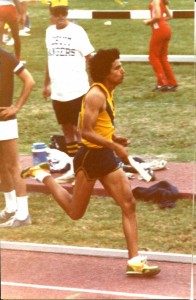 In this senior year, Najera knew that he had to run better in order to win an athletic scholarship; otherwise, he would have had to walk on. Training hard, he participated in the 800 m, mile, and mile relay. He went in all three events to the TCIL state meet, which was at Rice University. This was a spark in his college recruitment process, which Najera described as “all inside work. William Moore ’80, went to Rice to run. We kept in touch a lot, and I met the coach very early. I talked to the coach [after the TCIL meet] and he solidified a small scholarship to go to Rice.” Though he also talked to UT and Baylor, he was “deadset” on going to Rice with his former teammate.
In this senior year, Najera knew that he had to run better in order to win an athletic scholarship; otherwise, he would have had to walk on. Training hard, he participated in the 800 m, mile, and mile relay. He went in all three events to the TCIL state meet, which was at Rice University. This was a spark in his college recruitment process, which Najera described as “all inside work. William Moore ’80, went to Rice to run. We kept in touch a lot, and I met the coach very early. I talked to the coach [after the TCIL meet] and he solidified a small scholarship to go to Rice.” Though he also talked to UT and Baylor, he was “deadset” on going to Rice with his former teammate.
Once at Rice, he realized that he was going to have to move up, because he could only run a 50 second flat quarter, which “every good miler in college could.” So, he switched to the mile and the steeple chase (five barriers around a 3000 meter track just short of two miles). At the collegiate level, universities can race 9 guys, but only the top 5 guys score. Najera described himself as the “middleman of the team,” usually running between 4th and 6th place. Later in his Rice years, the he “had a weaker team,” and therefore finished #2 or #3 consistently.
Najera and his team twice finished 3rd at the Southwest Conference Championships, and were 3rd place back-to-back in the 1981 and 1982 NCAA Regional Championships.
After his junior year, Najera raced with the Plano Pacers Club, preparing over the summer for his final collegiate season. On one day in July 1984, Najera set a 10K record for the Club with a time of 31:37, a mark that still stands 30 years later.
Looking back on his running career, Najera explained that it “took awhile before [he] [could] consider enjoying running,” saying that eventually “you realize you can do six or seven miles and you feel good afterwards.” He prided himself in always being “consistent enough” to be a “solid performer to where I was always a strong member of the team.”
Though Najera notes that he was “for the most part very consistent in running and training, he admits that he “slacked off” after college when he married and started a family. He has had periods when he picked up running again, but really sees his running career as ending “after college.” One thing he regrets not doing is running a marathon when he was in “good shape” and could run “15-18 mile long runs” easy.
Reflecting on what qualities of his made him such a great runner, Najera first cited “physical capabilities,” yet added that a “great runner is more mental than anything else. You have to have confidence, you have to have patience, and tenacity. You cannot have the fear of failure or losing; otherwise, you get beat up every weekend. You run a lot of races, and you’re not going to win most of them. Some make you feel bad, while some you feel great. Patience is important because it takes awhile to improve. You have to stick to it and have the confidence that you can and will improve—staying with it and not letting go.”
 Najera’s greatest cross country/track memory was the state meet his senior year, for in every race he ran personal best, and set the school record in the 800 m. He also mentioned the “camaraderie” of the team, and “working [his] hardest.” One great friend he made during his running journey was William Moore, his teammate of seven years, roommate for a two years, and friend to this day.
Najera’s greatest cross country/track memory was the state meet his senior year, for in every race he ran personal best, and set the school record in the 800 m. He also mentioned the “camaraderie” of the team, and “working [his] hardest.” One great friend he made during his running journey was William Moore, his teammate of seven years, roommate for a two years, and friend to this day.
When Najera looks back on his Jesuit experience, he asserted that “not one event or specific memory” can define his experience, but that the “collective environment, the tradition of Men for Others” is what stands out. Though at the time he considered it normal, now he sees that “you don’t realize it while you are there in the moment.”
Najera’s son followed in his father’s footsteps, graduating Jesuit Class of 2005. Nowadays, Najera works in healthcare technology, the same industry he started in when he first left Rice in 1986 with a degree in Managerial Studies after switching majors from Electrical Engineering. Mainly working in payor processing of health care claims and systems, he has had positions at Etna, United, and various other healthcare entites. Over the years, he has increased his responsibilities, and for the past ten he has been a part of senior IT leadership. He now laughs when he remembers how he first experimented with computers at Jesuit, when the machines were the “size of a cabinet.”
What really stood out for Najera at Jesuit was its Men for Others philosophy; he explains that it has “grown a part of [him],” and that it is “all about giving back and sharing your talents for others, doing what you can and using your abilities.” Winning the Ranger Heart Award twice at Jesuit, Najera was a Big Brother and was active in community service. Even now, he still continues to be a prominent member of the Jesuit community. For fifteen years he has been helping out with the Jesuit phonathon, and regularly helps out at the Sheaner Relays as a meet official. For the past decade or so he has also participated in Jesuit’s Adopt-a-Family program, serving the last five years on the committee.
After being named into the Jesuit Sports Hall of Fame Class of 2014, Najera emphasizes that “it is a huge honor. The reason that it resonates with me is not so much what I’ve done on the track or sports-related it is also about what you have done off the track out of the sport and how you have made other contributions. That to me is what the biggest honor is.”
 The achievements of Najera on and off the field serve as an example to the Jesuit community on how to truly embody all aspects of the Profile. Throughout his running career, he has learned a lesson that not only applies to the track, but to life in general: “It is about patience–don’t expect anything to happen too fast. But if you put in the time and are consistent and you put in the effort, then [your goals] will be realized.”
The achievements of Najera on and off the field serve as an example to the Jesuit community on how to truly embody all aspects of the Profile. Throughout his running career, he has learned a lesson that not only applies to the track, but to life in general: “It is about patience–don’t expect anything to happen too fast. But if you put in the time and are consistent and you put in the effort, then [your goals] will be realized.”


